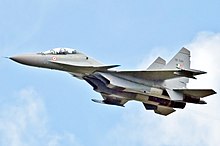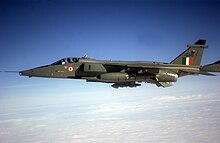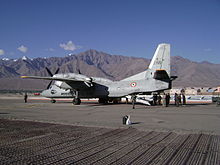Indian Air Force
|
Indian Air Force |
|
|---|---|

|
|
| Lineup | October 8, 1932 |
| Country |
|
| Type | Armed forces (air force) |
| motto |
English "Touch the Sky with Glory" German "Touch the sky with honor" |
| insignia | |
| Aircraft cockade |

|
| National emblem ( vertical stabilizer ) |
|
| Troop flag |

|
The Indian Air Force ( English Indian Air Force , Devanagari भारतीय वायु सेना Bhāratīya Vāyu Senā ) are the air forces of the Republic of India and the third branch of the Indian armed forces . They include around 170,000 soldiers .
history
The Royal Air Force in British India
The first missions of the Royal Air Force (RAF) in what was then British India , the first independent combat missions ever in its history, were flown in Wasiristan (today in Pakistan ) in the spring of 1925 during the Mahsud uprising. Three years later, the RAF evacuated over 500 people from Kabul .
On October 8, 1932, the Indian Air Force (IAF) was finally founded as an Auxiliary Air Force of the RAF , which began flight operations with four Westland Wapiti IIAs on April 1, 1933. Four and a half years later, the IAF flew its first missions, again in Wasiristan (from Miranshah ), this time against the Bhittani.

When the Second World War broke out , the IAF consisted of a single squadron, the 1st Squadron , 16 officers and 662 ranks. Until the outbreak of the Pacific War at the end of 1941, the IAF was gradually expanded. These included six coastal defense flights manned by volunteers , the establishment of a training program whose instructors were RAF members, and the establishment of two additional squadrons.
Due to the rapid conquest of British Malaya and Singapore by the Japanese invaders , the remains of the RAF machines stationed there were relocated to India, where the RAF was rebuilt in the Far East. In March 1945, the Air Command South-East Asia was subordinate to 71 squadrons, most of which were equipped with American-made aircraft. The IAF also contributed to this growth; at the end of 1944, its forces consisted of eight Hurricane and one Spitfire squadron; the Coastal Defense Flights had already been dissolved at the end of 1942. The operations focused on the fighting in Burma . Air sovereignty over Burma was secured in 1943 and General Slim , the local commander in chief of the British Army , could therefore rely on constant air supplies. Entire divisions were relocated to the Burmese theater of war by Allied transport planes, and in the spring of 1944 a 155,000-strong encircled force was supplied with 250 tons of supplies a day for 80 days. Due to their successful participation in the liberation of Burma, the IAF, which, as mentioned above, consisted exclusively of hunting squadrons, was given the prefix Royal in March 1945 .
In 1946 a squadron of the Royal Indian Air Force (RIAF) was in defeated Japan as part of the British Commonwealth Occupation Force (BCOF). In the same year the first air transport squadron was set up. Since the end of the war, the number of personnel had been reduced to 14,000 officers and soldiers. The hunting squadrons, which were temporarily equipped almost entirely with Spitfires, began to convert to the Tempest .
The Indian Air Force after independence
India gained independence in the summer of 1947 and as a result, the Royal Pakistan Air Force split off on August 15, 1947 . Immediately after the partition of India, the RIAF, which had lost a number of important airfields now in Pakistan, flew its first missions in Jammu and Kashmir . Parallel to these missions, an armistice came into force on January 1, 1949, the command structures including the central commands of the independent RIAF were established.
India became a republic in January 1950 and the prefix Royal was dropped. In the following years, the equipment of the Indian Air Force consisted mainly of British and some American aircraft types.
In the fall of 1953, the first French Ouragans arrived in India. At that point the IAF had the same strength as it had when it was divided in 1947. With this purchase, India began diversifying its sourcing, a hallmark that is still valid. In the following years there was a doubling of the flying squadrons, which went hand in hand with further modernization, so that in 1957 the last piston engine-powered aircraft were decommissioned.
The IAF's first UN mission took place in 1961/1962 at the request of the government of the newly independent Congo through six Canberras in the fallen province of Katanga . Immediately afterwards, at the end of 1962, there was a border war in the Himalayas with China , as a result of which the approximately 28,000-strong IAF was again greatly enlarged and Soviet aircraft types were procured for the first time. The IAF's targets were 100,000 men and 45 squadrons for the early 1970s. Until then, the IAF was geared towards operations on the western border, but now it has also been directed towards the northern and eastern borders. For this purpose, initially three regional operational command units were set up.
In September 1965 there was another brief war with Pakistan . The numerically superior IAF has some successes, especially through the light Gnat used as an interceptor , which shortly thereafter also became known in Western Europe as the Red Arrows pattern , but the quality of the IAF was generally inferior to the Pakistani opponents. Six years later there was a third war with Pakistan , with the course of which the IAF leadership was now satisfied.
After this last major conflict on the Indian subcontinent, the phase of consolidation began. India, as a non-aligned country, continued to procure the material for its air forces mainly in the Soviet Union. In addition, there were still some types from British and French as well as occasionally from (West) German production. There was also an increase in license production, in particular at the HAL company .
Another armed conflict over Jammu and Kashmir began in late May 1999 with Pakistan. The IAF air strikes during the Kargil War , however, proved unsuccessful.
Twenty years after the end of the East-West conflict, the IAF is still flying a large number of older types from the Soviet era. At the beginning of the 21st century, however, an extensive modernization program began in which British, Russian and, for the first time since the IAF's early years, American aircraft types were procured.
organization
The Indian Air Force is commanded by the Marshal of the Indian Air Force . It is at the headquarters of the Air Force, Air HQ , Chief of Staff , Chief of the Air Staff , to the side. The staff is divided into various areas of responsibility such as personnel, maintenance, inspection and aviation security as well as administration.
The deployment in the area is divided into five regional operational commandos, Air Commands , as the upper management level:
- Central Air Command in Prayagraj ,
- Southern Air Command in Thiruvananthapuram ,
- Eastern Air Command in Shillong ,
- South-West Air Command in Gandhinagar and
- Western Air Command in New Delhi .
The military airfields in their respective regions are subordinate to these (see below). There are also two regional functional commands for maintenance, maintenance , and training, training .
Aerobatic teams
future
The current planning is based on the 13th five-year financial plan for defense, the planning horizon of which extends into 2022. This year, the IAF will consist of around 40 squadrons with 700 to 800 multi-role combat aircraft. In addition to new combat aircraft, strategic transport and tanker aircraft are also to be procured, with which the traditional area of operation, the Indian subcontinent, can be left. The modernization is to be rounded off by a number of new helicopters. Many of the new machines are to be manufactured, at least in part, in the country, but currently mostly imported aircraft types are in operation, a total of more than 30 different types of aircraft and helicopters.
Originally, the IAF was to be expanded by 250 to 300 new stealth combat aircraft of the Sukhoi / HAL FGFA type and 126 new multi-purpose combat aircraft to replace the outdated MiG-21s . The American F-18 Superhornet and F-16IN Super Viper , the Eurofighter Typhoon from EADS, the French Dassault Rafale , the Russian MiG-35 and the Swedish JAS-39 Gripen were available. In April 2011, the Rafale and the Eurofighter were in the final selection. The announcement of the decision was delayed several times. In January 2012 the decision for the Rafale was announced. India withdrew from the FGFA program in 2018.
equipment
(As of end of 2014)
-
Warplanes :
- 194 Sukhoi Su-30PU / K / MKI , multi -role combat aircraft (a total of 272 ordered)
- 49 Dassault Mirage 2000 H (Vajra), multi-role combat aircraft
- 69 Mikoyan-Gurevich MiG-29 (Baaz), interceptor
- 122 Mikojan-Gurewitsch MiG-27 M (Bahadur), fighter-bomber (2019 out of service)
- 14 Mikoyan-Gurevich MiG-23 (Rakshak), fighter-bomber
- 157 Mikoyan-Gurevich MiG-21 , interceptor
- 118 SEPECAT Jaguar M / S (Shamsher) (12 more ordered), fighter-bomber
- 8 HAL Tejas (40 ordered), light combat aircraft
- Electronic reconnaissance aircraft:
- 1 IAI 1125 Astra , light reconnaissance aircraft (1 additional ordered)
- 1 Embraer R-99 (EMB-145SA AEW & C) , early warning aircraft (3 ordered)
- 1 Gulfstream III AEW , early warning aircraft
- 3 Beriev A-50 / Ilyushin Il-76AEW , early warning aircraft (2 more ordered in 2015)
-
Tanker and transport aircraft
- 7 Beriev A-50 (Il-78AEWMKI ), tanker aircraft
- 0 Airbus A330-200 MRTT , tanker aircraft (tender for initially 6 aircraft won in 2012)
- 1 IAI 1125 Astra, light liaison aircraft
- 57 Avro 748 M (Subroto), light transport aircraft
- 110 Antonov An-32 / 32RE (Sutleij), light transport aircraft
- 4 Lockheed Martin C-130J "Super Hercules" , tactical transport aircraft for special commands (originally six delivered from 2011, one of which crashed in 2014 and another badly damaged on the ground in 2017, six more re-ordered in 2013)
- 10 Boeing C-17A Globemaster III , strategic transport aircraft (1 reordered in 2017)
- 17 Ilyushin Il-76 MD (Gajaraj), strategic transport aircraft
- 40 Dornier Do 228 , liaison aircraft
-
Combat and transport helicopters
- 20 Mil Mi-35 "Hind-E" , attack helicopter
- 0 AH-64E Apache "Guardian" , attack helicopter (24 ordered, delivery 2019/20)
- 47 HAL Dhruv , light multipurpose helicopter (40 more ordered)
- 187 Mil Mi-8/17 "Hip" (Pratap), medium-weight transport helicopter (at least 80 more planned)
- 4 Mil Mi-26 , heavy transport and multipurpose helicopter
- 10 Aérospatiale SA315 , light multi-purpose helicopter
- 65 Aérospatiale SA319 , light multi-purpose helicopter
-
Training aircraft
- 12 Dassault Mirage 2000TH, two-seat fighter aircraft
- 31 SEPECAT Jaguar T (Shamsher), two-seater fighter aircraft
- 33 BAE Hawk Mk.132 , advanced trainer (initially 72, later again 57 plus 20 more ordered, a total of 143, including some for the Navy)
- 0 Pilatus PC-7MkII "Turbo Trainer" , basic trainer (initially 75 pieces ordered as a Kiran replacement, 145 planned in total, supply from 2013)
- 162 HAL HJT-16 Kiran, basic trainer
-
UAVs
- 100+ IAI Searchers
- 50+ IAI Heron
- unknown number of IAI Harpy
- 10 Lakshya PTA
bases
The military airfields , Air Force Stations (AFS), are subordinate to the five regional operational commandos. The IAF operates over 60 places, with the Western (between Punjab and Uttar Pradesh ) and the Eastern Air Command (in the east and northeast) being the two largest commands, each with well over a dozen. The South Western Air Command (across from Pakistan in Gujarat , Maharashtra and Rajasthan ) operates around a dozen AFS. This is followed by the Southern Air Command (including two bases on the Andaman and Nicobar Islands ) and the smallest, the Central Air Command (in Madhya Pradesh and neighboring regions). Half of the bases are to be upgraded in the next few years as part of the Modernization of Air Field Infrastructure (MAFI) program, which began in 2009 . Only some of the more important bases are listed below, for a more complete list see the list of airports in India .
- Western Air Command
- Ambala AFS, Amabala, Haryana , fighter aircraft base with Jaguar and in future first Rafale base ( 5th , 14th and 17th Squadron )
- Bathinda AFS, Bathinda , Punjab , ERJ-145 ( 200th Squadron , the first base modernized under the MAFI program until 2012)
- Halwara AFS, Halwara, Punjab, fighter aircraft base with Su-30 ( 220th and 221st Squadron )
- Hindon AFS, Ghaziabad , Uttar Pradesh , combat aircraft base near the capital with C-130J of special forces ( 77th Squadron ), C-17A ( 81st Squadron ) and some smaller units - the first station to be modernized
- Pathankot AFS, Pathankot , mixed base with MiG-21 ( 26th ), AH-64E ( 125th Squadron )
- Eastern Air Command
- Barrackpore AFS, Barrackpore, West Bengal , air transport base with Mi-17
- Chabua AFS, Chabua, Assam , fighter aircraft base with Su-30 ( 102nd Squadron ) and the Hawk retraining unit is being modernized
- Hasimara AFS, Alipurduar , West Bengal, fighter aircraft base, will be modernized, from 2020 second Rafale base ( 22nd and 222nd Squadron )
- Kalaikunda AFS, Kharagpur , West Bengal, fighter aircraft base
- Arjan Singh (formerly Panagarh) AFS, Panagarh , West Bengal, u. a. C-130J ( 87th Squadron ) and possibly also A330-200 MRTT
- Tezpur AFS, Tezpur , Assam, fighter aircraft base with Su-30 ( 2nd and 106th Squadron ) and some helicopters is being modernized
- Central Air Command
- Agra AFS, Agra , Uttar Pradesh, important transport air base, An-32 ( 12th ), An-50 ( 50th ) and Il-78 ( 78th Squadron ) in transport and early warning versions
- Bareilly AFS, Bareli , Uttar Pradesh, fighter aircraft base with Su-30 ( 8th and 24th Squadron ) and some helicopters
- Maharajpur AFS, Gwalior , Madhya Pradesh , fighter aircraft base with Mirage 2000 ( 1st , 7th and 9th Squadron ) and a test center
- South Western Air Command
- Lohegaon AFS , Pune , Maharashtra , fighter aircraft base with Su-30 ( 20th and 30th Squadron )
- Jodhpur AFS, Jodhpur, Rajasthan, combat aircraft base with MiG-21 ( 32nd Squadron ), Su-30 ( 31st Squadron ) and helicopters
- Southern Air Command
- Thanjavur AFS, Thanjavur , Tamil Nadu , new large base that opened on May 27, 2013
- Training Command
Incidents
- On April 27, 1975, a Hindustan Aeronautics HAL 748 of the Indian Air Force (IAF H-1520) was irreparably damaged in an aircraft accident in Yallahanpur. Further details are not known.
- On June 7, 1979, an Indian Air Force Hindustan Aeronautics HAL 748 (IAF H-2178) crashed into a mountain near the Karmwal Pass. All 28 inmates were killed.
- On March 25, 1991, a Hindustan Aeronautics HAL 748 of the Indian Air Force (IAF H-1513) barely rose when it took off from the Yelahanka Air Force Base and only reached a height of 50 meters. It collided with a stone wall, fell and caught fire. All 28 occupants, 3 crew members and 25 passengers were killed.
- On December 24, 1996, a Hindustan Aeronautics HAL 748 of the Indian Air Force (IAF H-1032) crashed near Dubagunta ( India ). First the left engine broke off and then the left wing. All 22 occupants, 4 crew members and 18 passengers were killed.
Web links
- Official homepage of the IAF (English)
- The Second World War on the official homepage of the RAF (English; PDF; 1.8 MB)
- [1]
- Badge of rank
Individual evidence
- ^ Flight International, US confirms India fighter rejection , accessed May 1, 2011.
- ↑ Hasnain Kazim: EADS loses a billion-dollar contract: India prefers to buy low-cost airlines. In: spiegel.de. January 31, 2012, accessed July 28, 2020 .
- ^ India withdraws from FGFA project, leaving Russia to go it alone. Jane's 360, May 23, 2018, accessed July 22, 2020 .
- ↑ . Janes, December 27, 2019
- ↑ India to fit six new C-130J s with terrain warning system, Janes, March 16, 2017 ( Memento of the original from March 16, 2017 in the Internet Archive ) Info: The archive link was inserted automatically and has not yet been checked. Please check the original and archive link according to the instructions and then remove this notice.
- ↑ Indian Air Force reading second airbase for Rafale fighters, Janes, December 12, 2018
- ↑ India deploys C-130J-30 transports near disputed border with China, Janes, July 28, 2017 ( Memento of the original from August 2, 2017 in the Internet Archive ) Info: The archive link was automatically inserted and not yet checked. Please check the original and archive link according to the instructions and then remove this notice.
- ^ Accident report HAL 748 IAF H-1520 , Aviation Safety Network (English), accessed on October 21, 2019.
- ^ Accident report HAL 748 IAF H-2178 , Aviation Safety Network (English), accessed on October 21, 2019.
- ↑ Accident report HAL 748 IAF H-1513 , Aviation Safety Network (English), accessed on October 21, 2019.
- ^ Accident report HAL 748 IAF H-1032 , Aviation Safety Network (English), accessed on October 21, 2019.







